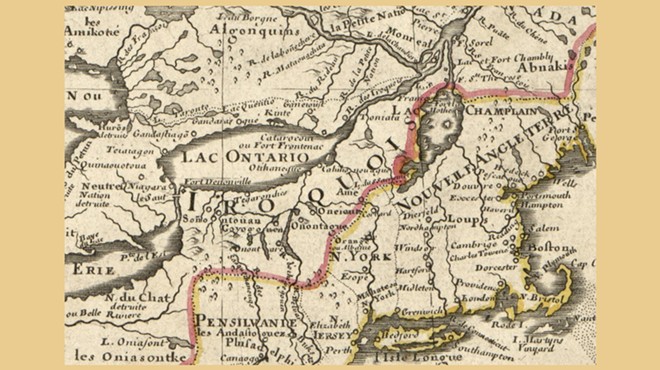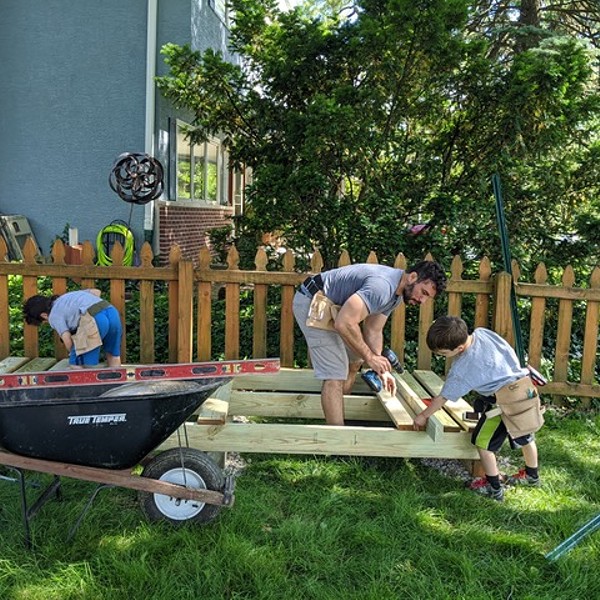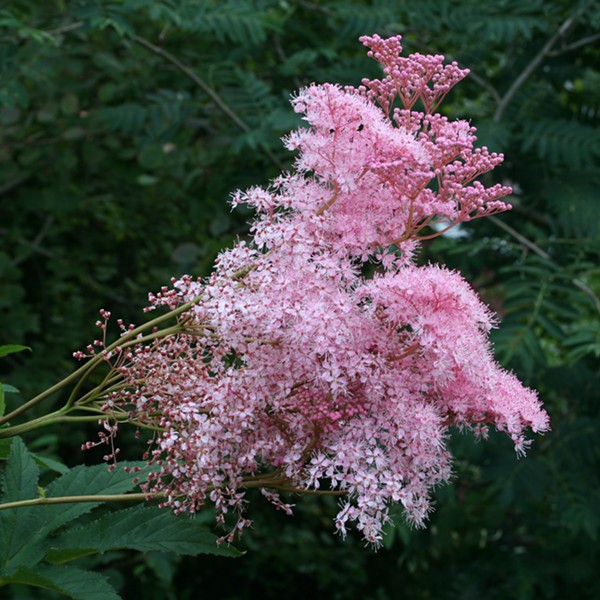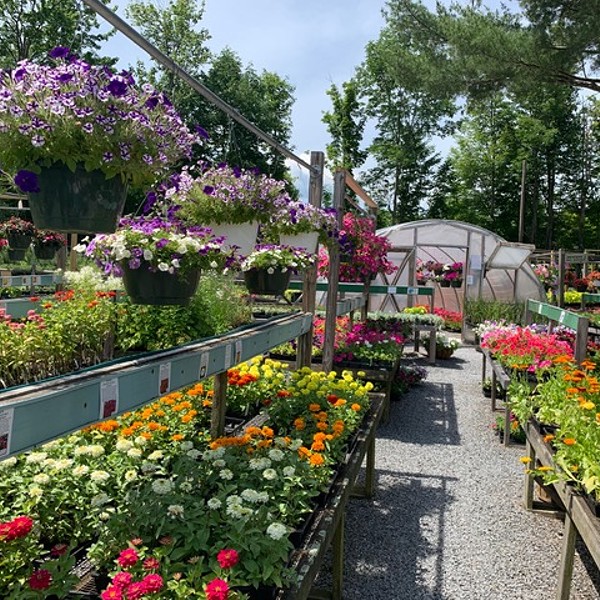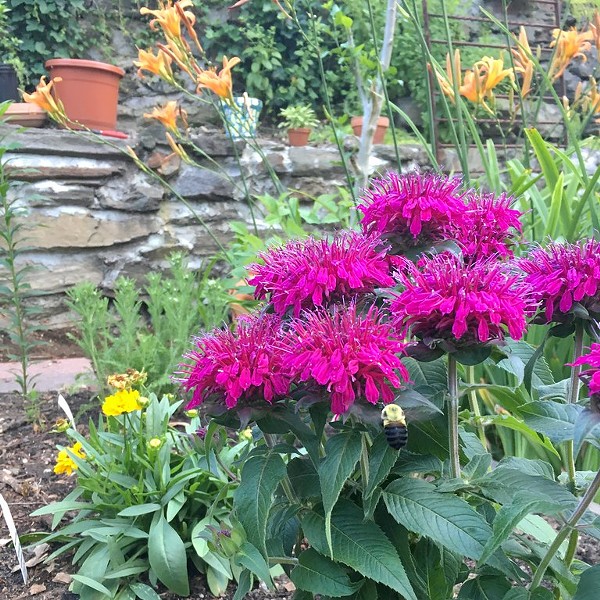The work was hot and hard, and more than once my thoughts turned to those Chinese intellectuals who, during the Cultural Revolution, were shipped to distant farms to erase Catullus from their minds and grow calluses on their hands. One day, Matt, mi hermano en trabajo, and I were terminating some bittersweet that had overtaken a planting bed, when a lawn crew arrived at the house across the street. When you’re a gardener in the suburbs, you get used to the mower jockeys who offload their rigs from the back of rattling trailers and roar around amid clouds of dust and exhaust, a look on their faces somewhere between boredom and madness. When a lawn service would show up at the same house where we were planting and pruning, there was rarely any interaction. I don’t think they quite knew what to make of us, since none of our tools required gasoline.
On this day, though, the guys across the street weren’t mowing, they were spraying. There were two of them, and each jacked on a backpack tank attached to a nozzle hose and went to work. There was a light breeze, and rain threatened, and it was altogether a stupid day to be spraying chemicals. Matt and I watched, dumbfounded. One of them, the bigger one with the expression of somebody who’d rather be on his Nintendo, gave no indication he knew a dandelion from his foot, and aimlessly sprayed whatever was in the tank on his shoes. The pair did their work, and before leaving, posted the perimeter of the yard with yellow warning signs.
In New York State, these yellow signs are as common in the suburbs as minivans. The wording on them, identical on every sign and obviously mandated by law, reads like some macabre poem: PESTICIDE APPLICATION/ DO NOT ENTER/ DO NOT REMOVE/ SIGN FOR 24 HOURS. State law requires professional lawn services to display these yellow flags after laying down any pesticide, as a way of informing homeowners and neighbors of the presence of freshly applied chemicals. Apply logic to this scenario for even a second, and it strikes you as lunacy. Not the signs—the application. Logically, if the chemicals were benign, there would be no need for a warning, ergo, there must be something worrisome, maybe even dangerous, about lawn pesticides. Criminy! One give-away is the word itself; the suffix –cide comes from the Latin for death, as in suicide, homicide, genocide.
A pesticide, of course, is aimed at a pest, but one man’s pest is another man’s clover. Pesticides don’t know a crabgrass from a honey bee, a song bird, a house cat, or a kid chasing his ball into a treated yard. They’re poisons, and another way to think about those yellow signs is to consider that every time one appears in the neighborhood, someone has decided, in the interest of their lawn, to introduce more poison into the environment. The wording of the signs invites us to infer that the danger is gone in 24 hours. But that’s only the time it takes for the chemicals to dry, which makes them less likely to spread, but by no means harmless. There are more than a dozen “probable or likely human carcinogens” listed by the Environmental Protective Agency as active ingredients in the 175 turf and lawn products registered for use in New York. And that’s just cancer. Exposure to lawn pesticides is associated with asthma, developmental and learning disabilities, immune system damage, birth defects, endocrine disruption, liver and kidney disease, and other disorders.
There’s no way of knowing how dangerous lawn chemicals are, since the research on them is incomplete. Most chemicals are tested for their acute effects on humans—what happens if you spray them in your eyes or swallow them, for instance. But recent medical research is focusing on the long-term effects of exposure to even low doses of common chemicals, and the findings are troubling. Of course, there are powerful corporate interests that benefit from scientific uncertainty, and for the past six years, the EPA, which either conducts or funds much of the testing on lawn chemicals, has been in the control of people sympathetic to such interests.
The large pesticide companies and chemical-lawn franchises would have us accept that, yes, there may risk, but what in life is risk-free? The fact is, as much as I’d like all my food organic, all my meat free-range, and all the world’s mosquitoes to disappear on their own, modern comfort and survival are based on a thousand little deals with chemical devils. We drink their Kool-Aid and hope to hold them in check. Some risks might be worth it, but lawns? The average suburban neighborhood receives more pesticide per acre than agricultural land, nearly all of to maintain a monoculture of grass-only lawns to appease homeowner vanity. There are numerous real advantages to lawns, from keeping away snakes to cooling the environment, but none of them is increased if the lawn has some chickweed, plantain or speedwell in it. Pesticides, especially the weed-and-seed variety, are little more than private aesthetic indulgences at the expense of public health.
Look again at the picture on those yellow tags. A family scene—grown-up, child, and pet—floating in a circle and riven by a black slash. As an illustration of the written warning, it’s obvious what this means. But symbols have a way of morphing their meaning. It’s about more than lawns. Think of that family as our common humanity, and that circle as our tiny planet. What, then, should we make of that dark line? Once upon a time, before I was the potentate of a monthly magazine, I lived the free life of a gardener. Actually, I was a gardener’s laborer, one of those hunched workers with dirty hands and sore backs who pull weeds, shovel mulch, and plant trees while others pursue lives as physicians, attorneys, insurance men, and editors. Sandy, the owner of the company, was an inspired landscape designer, a true artist for whom a few clumps of Rudbeckia had the same potential a tube of cadmium yellow had to Van Gogh. Her designs had a timeless quality, as did her methods—we worked without those two necessities of modern gardening, power tools and chemicals.
The work was hot and hard, and more than once my thoughts turned to those Chinese intellectuals who, during the Cultural Revolution, were shipped to distant farms to erase Catullus from their minds and grow calluses on their hands. One day, Matt, mi hermano en trabajo, and I were terminating some bittersweet that had overtaken a planting bed, when a lawn crew arrived at the house across the street. When you’re a gardener in the suburbs, you get used to the mower jockeys who offload their rigs from the back of rattling trailers and roar around amid clouds of dust and exhaust, a look on their faces somewhere between boredom and madness. When a lawn service would show up at the same house where we were planting and pruning, there was rarely any interaction. I don’t think they quite knew what to make of us, since none of our tools required gasoline.
On this day, though, the guys across the street weren’t mowing, they were spraying. There were two of them, and each jacked on a backpack tank attached to a nozzle hose and went to work. There was a light breeze, and rain threatened, and it was altogether a stupid day to be spraying chemicals. Matt and I watched, dumbfounded. One of them, the bigger one with the expression of somebody who’d rather be on his Nintendo, gave no indication he knew a dandelion from his foot, and aimlessly sprayed whatever was in the tank on his shoes. The pair did their work, and before leaving, posted the perimeter of the yard with yellow warning signs.
In New York State, these yellow signs are as common in the suburbs as minivans. The wording on them, identical on every sign and obviously mandated by law, reads like some macabre poem: PESTICIDE APPLICATION/ DO NOT ENTER/ DO NOT REMOVE/ SIGN FOR 24 HOURS. State law requires professional lawn services to display these yellow flags after laying down any pesticide, as a way of informing homeowners and neighbors of the presence of freshly applied chemicals. Apply logic to this scenario for even a second, and it strikes you as lunacy. Not the signs—the application. Logically, if the chemicals were benign, there would be no need for a warning, ergo, there must be something worrisome, maybe even dangerous, about lawn pesticides. Criminy! One give-away is the word itself; the suffix –cide comes from the Latin for death, as in suicide, homicide, genocide.
A pesticide, of course, is aimed at a pest, but one man’s pest is another man’s clover. Pesticides don’t know a crabgrass from a honey bee, a song bird, a house cat, or a kid chasing his ball into a treated yard. They’re poisons, and another way to think about those yellow signs is to consider that every time one appears in the neighborhood, someone has decided, in the interest of their lawn, to introduce more poison into the environment. The wording of the signs invites us to infer that the danger is gone in 24 hours. But that’s only the time it takes for the chemicals to dry, which makes them less likely to spread, but by no means harmless. There are more than a dozen “probable or likely human carcinogens” listed by the Environmental Protective Agency as active ingredients in the 175 turf and lawn products registered for use in New York. And that’s just cancer. Exposure to lawn pesticides is associated with asthma, developmental and learning disabilities, immune system damage, birth defects, endocrine disruption, liver and kidney disease, and other disorders.
There’s no way of knowing how dangerous lawn chemicals are, since the research on them is incomplete. Most chemicals are tested for their acute effects on humans—what happens if you spray them in your eyes or swallow them, for instance. But recent medical research is focusing on the long-term effects of exposure to even low doses of common chemicals, and the findings are troubling. Of course, there are powerful corporate interests that benefit from scientific uncertainty, and for the past six years, the EPA, which either conducts or funds much of the testing on lawn chemicals, has been in the control of people sympathetic to such interests.
The large pesticide companies and chemical-lawn franchises would have us accept that, yes, there may risk, but what in life is risk-free? The fact is, as much as I’d like all my food organic, all my meat free-range, and all the world’s mosquitoes to disappear on their own, modern comfort and survival are based on a thousand little deals with chemical devils. We drink their Kool-Aid and hope to hold them in check. Some risks might be worth it, but lawns? The average suburban neighborhood receives more pesticide per acre than agricultural land, nearly all of to maintain a monoculture of grass-only lawns to appease homeowner vanity. There are numerous real advantages to lawns, from keeping away snakes to cooling the environment, but none of them is increased if the lawn has some chickweed, plantain or speedwell in it. Pesticides, especially the weed-and-seed variety, are little more than private aesthetic indulgences at the expense of public health.
Look again at the picture on those yellow tags. A family scene—grown-up, child, and pet—floating in a circle and riven by a black slash. As an illustration of the written warning, it’s obvious what this means. But symbols have a way of morphing their meaning. It’s about more than lawns. Think of that family as our common humanity, and that circle as our tiny planet. What, then, should we make of that dark line?








